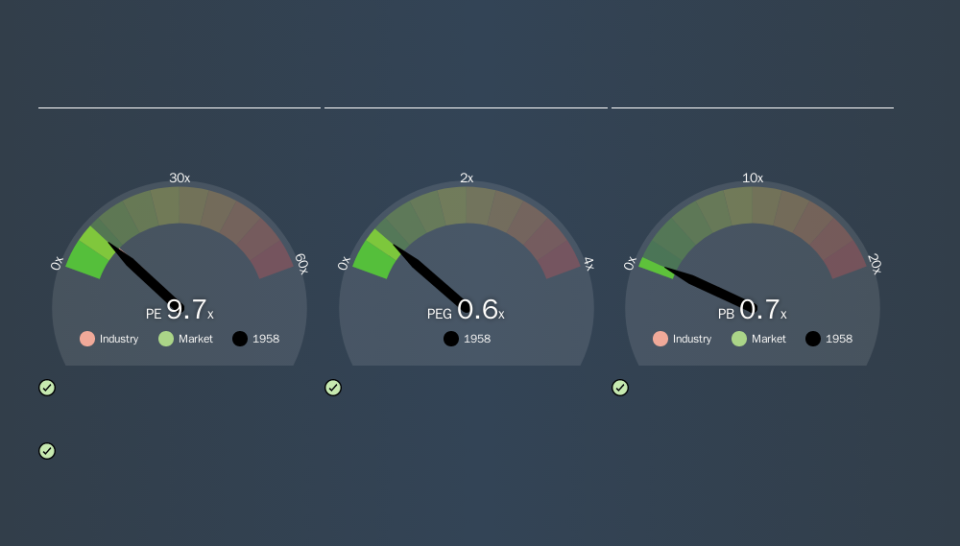Here's How P/E Ratios Can Help Us Understand BAIC Motor Corporation Limited (HKG:1958)

Today, we'll introduce the concept of the P/E ratio for those who are learning about investing. We'll look at BAIC Motor Corporation Limited's (HKG:1958) P/E ratio and reflect on what it tells us about the company's share price. BAIC Motor has a price to earnings ratio of 9.75, based on the last twelve months. That means that at current prices, buyers pay HK$9.75 for every HK$1 in trailing yearly profits.
View our latest analysis for BAIC Motor
How Do You Calculate BAIC Motor's P/E Ratio?
The formula for price to earnings is:
Price to Earnings Ratio = Share Price (in reporting currency) ÷ Earnings per Share (EPS)
Or for BAIC Motor:
P/E of 9.75 = HK$4.26 (Note: this is the share price in the reporting currency, namely, CNY ) ÷ HK$0.44 (Based on the trailing twelve months to June 2019.)
Is A High Price-to-Earnings Ratio Good?
A higher P/E ratio implies that investors pay a higher price for the earning power of the business. That is not a good or a bad thing per se, but a high P/E does imply buyers are optimistic about the future.
Does BAIC Motor Have A Relatively High Or Low P/E For Its Industry?
The P/E ratio essentially measures market expectations of a company. You can see in the image below that the average P/E (10.5) for companies in the auto industry is roughly the same as BAIC Motor's P/E.
Its P/E ratio suggests that BAIC Motor shareholders think that in the future it will perform about the same as other companies in its industry classification. So if BAIC Motor actually outperforms its peers going forward, that should be a positive for the share price. Checking factors such as director buying and selling. could help you form your own view on if that will happen.
How Growth Rates Impact P/E Ratios
When earnings fall, the 'E' decreases, over time. Therefore, even if you pay a low multiple of earnings now, that multiple will become higher in the future. Then, a higher P/E might scare off shareholders, pushing the share price down.
BAIC Motor saw earnings per share decrease by 17% last year. And EPS is down 1.4% a year, over the last 5 years. This might lead to muted expectations.
A Limitation: P/E Ratios Ignore Debt and Cash In The Bank
The 'Price' in P/E reflects the market capitalization of the company. In other words, it does not consider any debt or cash that the company may have on the balance sheet. Hypothetically, a company could reduce its future P/E ratio by spending its cash (or taking on debt) to achieve higher earnings.
Such expenditure might be good or bad, in the long term, but the point here is that the balance sheet is not reflected by this ratio.
Is Debt Impacting BAIC Motor's P/E?
BAIC Motor has net cash of CN¥19b. This is fairly high at 55% of its market capitalization. That might mean balance sheet strength is important to the business, but should also help push the P/E a bit higher than it would otherwise be.
The Verdict On BAIC Motor's P/E Ratio
BAIC Motor's P/E is 9.7 which is about average (10.2) in the HK market. While the absence of growth in the last year is probably causing a degree of pessimism, the healthy balance sheet means the company retains potential for future growth. So it's not surprising to see it trade on a P/E roughly in line with the market.
Investors should be looking to buy stocks that the market is wrong about. As value investor Benjamin Graham famously said, 'In the short run, the market is a voting machine but in the long run, it is a weighing machine. So this free report on the analyst consensus forecasts could help you make a master move on this stock.
But note: BAIC Motor may not be the best stock to buy. So take a peek at this free list of interesting companies with strong recent earnings growth (and a P/E ratio below 20).
We aim to bring you long-term focused research analysis driven by fundamental data. Note that our analysis may not factor in the latest price-sensitive company announcements or qualitative material.
If you spot an error that warrants correction, please contact the editor at editorial-team@simplywallst.com. This article by Simply Wall St is general in nature. It does not constitute a recommendation to buy or sell any stock, and does not take account of your objectives, or your financial situation. Simply Wall St has no position in the stocks mentioned. Thank you for reading.


